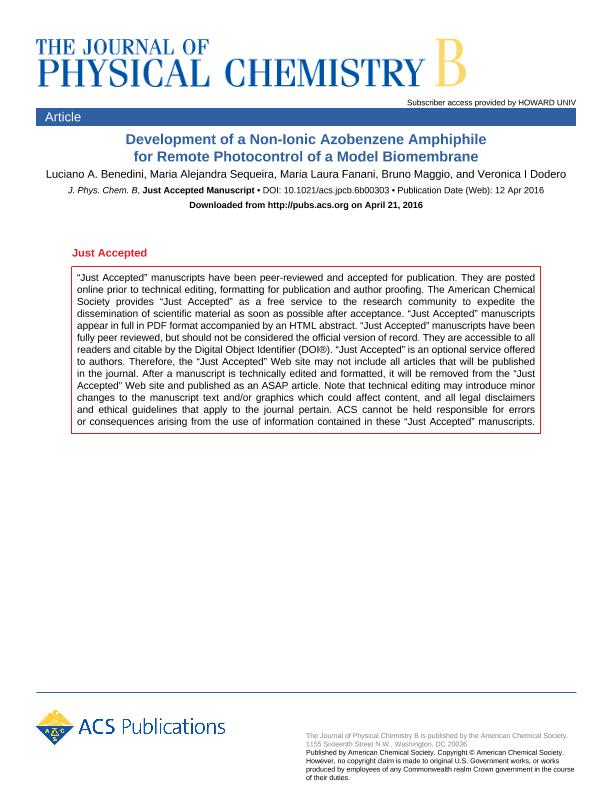Artículo
Development of a nonionic azobenzene amphiphile for remote photocontrol of a model biomembrane
Benedini, Luciano Alejandro ; Sequeira, María Alejandra
; Sequeira, María Alejandra ; Fanani, Maria Laura
; Fanani, Maria Laura ; Maggio, Bruno
; Maggio, Bruno ; Dodero, Veronica Isabel
; Dodero, Veronica Isabel
 ; Sequeira, María Alejandra
; Sequeira, María Alejandra ; Fanani, Maria Laura
; Fanani, Maria Laura ; Maggio, Bruno
; Maggio, Bruno ; Dodero, Veronica Isabel
; Dodero, Veronica Isabel
Fecha de publicación:
25/05/2016
Editorial:
American Chemical Society
Revista:
Journal of Physical Chemistry B
ISSN:
1520-6106
e-ISSN:
1520-5207
Idioma:
Inglés
Tipo de recurso:
Artículo publicado
Clasificación temática:
Resumen
We report the synthesis and characterization of a simple nonionic azoamphiphile, C12OazoE3OH, which behaves as an optically controlled molecule alone and in a biomembrane environment. First, Langmuir monolayer and Brewster angle microscopy (BAM) experiments showed that pure C12OazoE3OH enriched in the (E) isomer was able to form solidlike mesophase even at low surface pressure associated with supramolecular organization of the azobenzene derivative at the interface. On the other hand, pure C12OazoE3OH enriched in the (Z) isomer formed a less solidlike monolayer due to the bent geometry around the azobenzene moiety. Second, C12OazoE3OH is well-mixed in a biological membrane model, Lipoid s75 (up to 20%mol), and photoisomerization among the lipids proceeded smoothly depending on light conditions. It is proposed that the cross-sectional area of the hydroxyl triethylenglycol head of C12OazoE3OH inhibits azobenzenes H-aggregation in the model membrane; thus, the tails conformation change due to photoisomerization is transferred efficiently to the lipid membrane. We showed that the lipid membrane effectively senses the azobenzene geometrical change photomodulating some properties, like compressibility modulus, transition temperature, and morphology. In addition, photomodulation proceeds with a color change from yellow to orange, providing the possibility to externally monitor the system. Finally, Gibbs monolayers showed that C12OazoE3OH is able to penetrate the highly packing biomembrane model; thus, C12OazoE3OH might be used as photoswitchable molecular probe in real systems.
Palabras clave:
Azobenzenes
,
Remote Photocontrol
,
Model Biomembrane
Archivos asociados
Licencia
Identificadores
Colecciones
Articulos(CIQUIBIC)
Articulos de CENTRO DE INVEST.EN QCA.BIOL.DE CORDOBA (P)
Articulos de CENTRO DE INVEST.EN QCA.BIOL.DE CORDOBA (P)
Articulos(INQUISUR)
Articulos de INST.DE QUIMICA DEL SUR
Articulos de INST.DE QUIMICA DEL SUR
Citación
Benedini, Luciano Alejandro; Sequeira, María Alejandra; Fanani, Maria Laura; Maggio, Bruno; Dodero, Veronica Isabel; Development of a nonionic azobenzene amphiphile for remote photocontrol of a model biomembrane; American Chemical Society; Journal of Physical Chemistry B; 120; 17; 25-5-2016; 4053-4063
Compartir
Altmétricas



